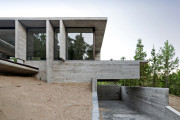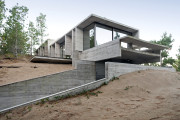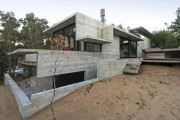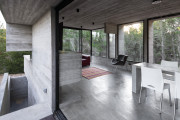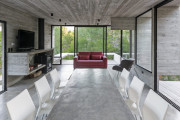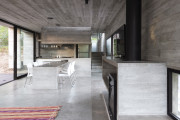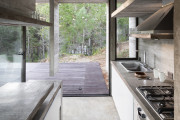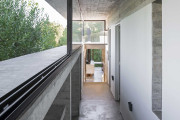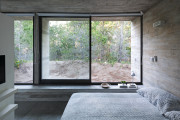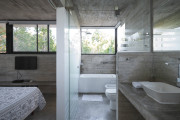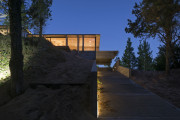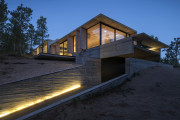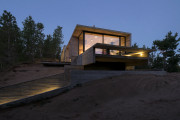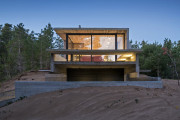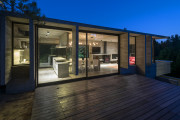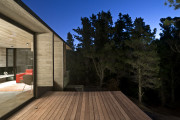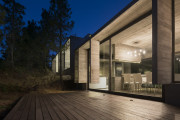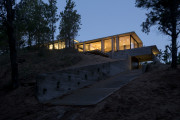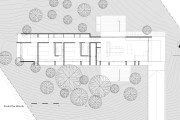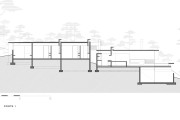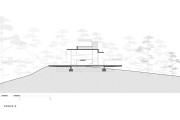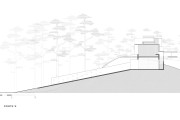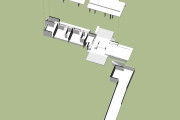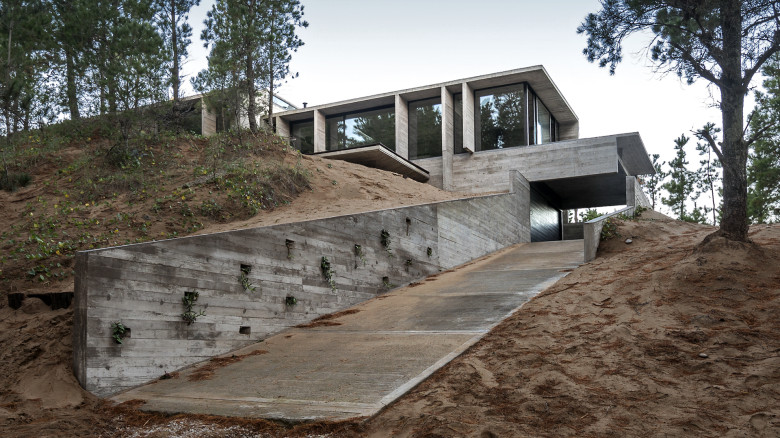Wein House
Location: Costa Esmeralda, Buenos Aires Province, Argentina
Design and Project Management: María Victoria Besonías, Guillermo de Almeida
Collaborators: Arch. Florencia Testa, Denisse Gerard
Land area: 1300 sqm
Built area: 167 sqm
Construction year: 2015
Photos: Daniela McAdden
Memory
The place
Costa Esmeralda is a real estate development over the dunes on the coast, 390 km from Buenos Aires. This is a recent urban development with young acacias and pines forestation and some sectors of consolidated forest.
The lot to intervene is a high rise dune with the peculiarity of having in part aged woods and also a recent pine plantation, although undoubtedly its most prominent feature is the abruptness of its relief. Between the access road and the highest sector of the lot, located approx. in the plot center, there is a height difference of 12 m, so that in order to access to it is necessary to ascend a slope of more than 45 °.
The commission
The request was a house with an aesthetic-constructive proposal similar to those built in the forest of Mar Azul, appreciated by the clients both for its formal austerity as for the low maintenance required.
Designed to be generally used by two families with young children, the house had to have a generous place for meetings, a kitchen visually integrated to it, and three bedrooms, two of them en suite. The house must also resolve the two quads and beach items storage. Also, and especially, the clients mentioned the need for the house to feature expansion terraces and large glass panels to enjoy the scenery, because they emphasized of the chosen location the distant views to a privileged environment: a dense young forest, that due to the characteristics of urbanization, is free from the possibility that neighboring buildings may modify it in the future.
The proposal
This situation of “lookout house” required by the clients was the first major challenge to undergo on the proposal. It was necessary to solve the issue of accessing the house once built, but also during the construction stage.
So the project started to be generated from a ramp which, cutting the dune, will save the highest height possible, thus allowing access of materials and personnel during the execution and, once finished, would serve as a vehicular access to a parking area. From there it’s necessary to continue stairs up (outdoor and indoor) to the highest point of the dune to enjoy those spectacular views.
The house was then volumetrically defined by the deep mark of the ramp and two superimposed to it and aligned with each other in the direction of the slope (oblique to the lot) and, with 1.20m height difference between them, fit in the relief of the dune.
These two volumes orient one face to the north, so that all the rooms of the house receive sunlight controlled by overhangs and vertical partitions. The opposite south façade, with an opening on the volume of bedrooms that runs along its entire length, ensures illumination on circulations and allows cross ventilation.
The functional organization
You reach the house by car or as a pedestrian up the ramp (with slope of 20%) to the partially covered garage with an attached tank. From there, saving an unevenness of a floor with a staircase also partially covered, you access to an open floor with one fixed element (counter – table – separator) which gives privacy to the kitchen sector in relation with the rest of the social area. The activities on this floor of the house have its expansion onto three terraces, which also fulfill the function of being places of contemplation of the surrounding landscape.
Going up a staircase again, but this time indoor and bridging an intermediate level, is reached a circulation along which are accessible in the first place the main bathroom and then the three bedrooms.
Two of the bathrooms in this sector, which are situated in the center of the plan, are illuminated and vented through openings in the roof.
Structural solution
The volumes are solved with slabs of H º A º, supported in bearing walls through simple beams on the south façade, and through closed inverted beams on the north side to capture more light. The partitions are grounded in the dune by perimeter beams. The volume which covers the garage was designed as a cantilever which rests on two major beams, to make evident the independence of the structural system that solves the dune rise and the house itself.
The construction
The work was done in exposed concrete, a material that unifies in a single element structure and finishing. H21 concrete was used with the addition of a fluidifiant so that this mixture, with little amount of water to harden, results very compact and doesn’t require sealing. Furthermore, the expressive quality of concrete and its resistance and impermeability, made superfluous any type of surface finish. It achieves a low cost of execution at finishing and needless future maintenance.
Cross ventilation was taken under account both in bedrooms and on the main floor to allow air circulation and thus to ensure the house will be refresh with the sea breeze in summer.
The heating system of this house is given by the use of hot and cold air conditioners. Was also included a home-salamander to complement the heating system.
The few interior partition walls are of brick, plastered and painted with white latex. Bathrooms feature white enameled ceramic coating on the walls that are not of concrete. The floor cloths are also from concrete screed divided with aluminum plates. The meeting between walls and the floor was resolved with a recessed aluminum profile, as a base.
La propuesta
El proyecto empezó a generarse a partir de una rampa que, cortando el médano, salvara la mayor altura posible permitiendo así el acceso de materiales y personal durante la ejecución y que, una vez finalizada, sirviera de acceso vehicular hasta una zona de estacionamiento. Desde allí habría que seguir subiendo con escaleras (exteriores e interiores) hasta llegar a la zona más alta del médano para poder disfrutar de aquellas vistas privilegiadas.
La casa quedó entonces definida volumétricamente por la huella profunda de la rampa y por dos prismas que se le enciman, alineados entre sí, siguiendo la dirección de la pendiente (oblicua respecto del lote) y que, con diferencia de 1.20m de altura entre ellos, se acomodan al relieve del médano.
Esos dos volúmenes orientan una de sus caras al norte, de manera que todos los ambientes de la casa reciben sol controlado por aleros y tabiques verticales. La fachada sur, con una abertura en el volumen de los dormitorios que recorre toda su longitud, asegura iluminación en las circulaciones y posibilita la ventilación cruzada.
La organización funcional
Se accede a la vivienda en automóvil o peatonalmente subiendo la rampa hasta la cochera semicubierta con un depósito anexo. Desde allí, salvando un desnivel de un piso con una escalera también semicubierta, se accede a una planta libre con un solo elemento fijo (mesada-mesa-separador) que otorga privacidad al sector cocina en relación con el resto de la zona social. Las actividades de este nivel de la casa tienen su expansión en tres terrazas que cumplen también con la función de ser lugares de contemplación del paisaje circundante.
Subiendo nuevamente una escalera, pero esta vez interior y salvando medio nivel, se llega a una circulación a lo largo de la cual se accede en primer lugar al baño general y luego a los tres dormitorios.
Dos de los baños de este sector que se encuentran en el centro de la planta se iluminan y ventilan a través de aberturas en el techo.
La solución estructural
Los volúmenes se resuelven con losas de Hº Aº que apoyan en tabiques portantes a través de vigas simples en la fachada al sur, más cerrada, y a través de vigas invertidas en la fachada norte para captar la mayor cantidad de luz. Los tabiques se fundan en el médano por medio de vigas perimetrales. El volumen que cubre la cochera se proyectó como un voladizo que descansa en dos importantes vigas para hacer más evidente la independencia entre el sistema estructural que resuelve la subida al médano y la casa en sí.
La construcción
Se utilizó un Hormigón H21 con el agregado de un fluidificante para conseguir una mezcla con escasa cantidad de agua que al fraguar resulte de mucha compacidad. Gracias a este procedimiento la calidad expresiva del hormigón visto resultante y sus propiedades de resistencia e impermeabilidad, hacen innecesario cualquier tipo de acabado superficial.
Se previó en todos los ambientes ventilación cruzada para que la brisa marina los refresque y sólo sea necesario recurrir a medios de refrigeración en días de temperaturas extremas.
La calefacción de los diferentes ambientes se realizó utilizando un sistema de piso radiante, también se incluyó un hogar-salamandra.
Los escasos tabiques interiores son de ladrillos huecos revocados y pintados con látex blanco. El piso es de paños de cemento alisado divididos por planchuelas de aluminio. El encuentro entre muros y suelo se resolvió con un perfil rehundido de aluminio a manera de zócalo.
Wein House
Location: Costa Esmeralda, Buenos Aires Province, Argentina
Design and Project Management: María Victoria Besonías, Guillermo de Almeida
Collaborators: Arch. Florencia Testa, Denisse Gerard
Land area: 1300 sqm
Built area: 167 sqm
Construction year: 2015
Photos: Daniela McAdden
Memory
The place
Costa Esmeralda is a real estate development over the dunes on the coast, 390 km from Buenos Aires. This is a recent urban development with young acacias and pines forestation and some sectors of consolidated forest.
The lot to intervene is a high rise dune with the peculiarity of having in part aged woods and also a recent pine plantation, although undoubtedly its most prominent feature is the abruptness of its relief. Between the access road and the highest sector of the lot, located approx. in the plot center, there is a height difference of 12 m, so that in order to access to it is necessary to ascend a slope of more than 45 °.
The commission
The request was a house with an aesthetic-constructive proposal similar to those built in the forest of Mar Azul, appreciated by the clients both for its formal austerity as for the low maintenance required.
Designed to be generally used by two families with young children, the house had to have a generous place for meetings, a kitchen visually integrated to it, and three bedrooms, two of them en suite. The house must also resolve the two quads and beach items storage. Also, and especially, the clients mentioned the need for the house to feature expansion terraces and large glass panels to enjoy the scenery, because they emphasized of the chosen location the distant views to a privileged environment: a dense young forest, that due to the characteristics of urbanization, is free from the possibility that neighboring buildings may modify it in the future.
The proposal
This situation of “lookout house” required by the clients was the first major challenge to undergo on the proposal. It was necessary to solve the issue of accessing the house once built, but also during the construction stage.
So the project started to be generated from a ramp which, cutting the dune, will save the highest height possible, thus allowing access of materials and personnel during the execution and, once finished, would serve as a vehicular access to a parking area. From there it’s necessary to continue stairs up (outdoor and indoor) to the highest point of the dune to enjoy those spectacular views.
The house was then volumetrically defined by the deep mark of the ramp and two superimposed to it and aligned with each other in the direction of the slope (oblique to the lot) and, with 1.20m height difference between them, fit in the relief of the dune.
These two volumes orient one face to the north, so that all the rooms of the house receive sunlight controlled by overhangs and vertical partitions. The opposite south façade, with an opening on the volume of bedrooms that runs along its entire length, ensures illumination on circulations and allows cross ventilation.
The functional organization
You reach the house by car or as a pedestrian up the ramp (with slope of 20%) to the partially covered garage with an attached tank. From there, saving an unevenness of a floor with a staircase also partially covered, you access to an open floor with one fixed element (counter – table – separator) which gives privacy to the kitchen sector in relation with the rest of the social area. The activities on this floor of the house have its expansion onto three terraces, which also fulfill the function of being places of contemplation of the surrounding landscape.
Going up a staircase again, but this time indoor and bridging an intermediate level, is reached a circulation along which are accessible in the first place the main bathroom and then the three bedrooms.
Two of the bathrooms in this sector, which are situated in the center of the plan, are illuminated and vented through openings in the roof.
Structural solution
The volumes are solved with slabs of H º A º, supported in bearing walls through simple beams on the south façade, and through closed inverted beams on the north side to capture more light. The partitions are grounded in the dune by perimeter beams. The volume which covers the garage was designed as a cantilever which rests on two major beams, to make evident the independence of the structural system that solves the dune rise and the house itself.
The construction
The work was done in exposed concrete, a material that unifies in a single element structure and finishing. H21 concrete was used with the addition of a fluidifiant so that this mixture, with little amount of water to harden, results very compact and doesn’t require sealing. Furthermore, the expressive quality of concrete and its resistance and impermeability, made superfluous any type of surface finish. It achieves a low cost of execution at finishing and needless future maintenance.
Cross ventilation was taken under account both in bedrooms and on the main floor to allow air circulation and thus to ensure the house will be refresh with the sea breeze in summer.
The heating system of this house is given by the use of hot and cold air conditioners. Was also included a home-salamander to complement the heating system.
The few interior partition walls are of brick, plastered and painted with white latex. Bathrooms feature white enameled ceramic coating on the walls that are not of concrete. The floor cloths are also from concrete screed divided with aluminum plates. The meeting between walls and the floor was resolved with a recessed aluminum profile, as a base.
La propuesta
El proyecto empezó a generarse a partir de una rampa que, cortando el médano, salvara la mayor altura posible permitiendo así el acceso de materiales y personal durante la ejecución y que, una vez finalizada, sirviera de acceso vehicular hasta una zona de estacionamiento. Desde allí habría que seguir subiendo con escaleras (exteriores e interiores) hasta llegar a la zona más alta del médano para poder disfrutar de aquellas vistas privilegiadas.
La casa quedó entonces definida volumétricamente por la huella profunda de la rampa y por dos prismas que se le enciman, alineados entre sí, siguiendo la dirección de la pendiente (oblicua respecto del lote) y que, con diferencia de 1.20m de altura entre ellos, se acomodan al relieve del médano.
Esos dos volúmenes orientan una de sus caras al norte, de manera que todos los ambientes de la casa reciben sol controlado por aleros y tabiques verticales. La fachada sur, con una abertura en el volumen de los dormitorios que recorre toda su longitud, asegura iluminación en las circulaciones y posibilita la ventilación cruzada.
La organización funcional
Se accede a la vivienda en automóvil o peatonalmente subiendo la rampa hasta la cochera semicubierta con un depósito anexo. Desde allí, salvando un desnivel de un piso con una escalera también semicubierta, se accede a una planta libre con un solo elemento fijo (mesada-mesa-separador) que otorga privacidad al sector cocina en relación con el resto de la zona social. Las actividades de este nivel de la casa tienen su expansión en tres terrazas que cumplen también con la función de ser lugares de contemplación del paisaje circundante.
Subiendo nuevamente una escalera, pero esta vez interior y salvando medio nivel, se llega a una circulación a lo largo de la cual se accede en primer lugar al baño general y luego a los tres dormitorios.
Dos de los baños de este sector que se encuentran en el centro de la planta se iluminan y ventilan a través de aberturas en el techo.
La solución estructural
Los volúmenes se resuelven con losas de Hº Aº que apoyan en tabiques portantes a través de vigas simples en la fachada al sur, más cerrada, y a través de vigas invertidas en la fachada norte para captar la mayor cantidad de luz. Los tabiques se fundan en el médano por medio de vigas perimetrales. El volumen que cubre la cochera se proyectó como un voladizo que descansa en dos importantes vigas para hacer más evidente la independencia entre el sistema estructural que resuelve la subida al médano y la casa en sí.
La construcción
Se utilizó un Hormigón H21 con el agregado de un fluidificante para conseguir una mezcla con escasa cantidad de agua que al fraguar resulte de mucha compacidad. Gracias a este procedimiento la calidad expresiva del hormigón visto resultante y sus propiedades de resistencia e impermeabilidad, hacen innecesario cualquier tipo de acabado superficial.
Se previó en todos los ambientes ventilación cruzada para que la brisa marina los refresque y sólo sea necesario recurrir a medios de refrigeración en días de temperaturas extremas.
La calefacción de los diferentes ambientes se realizó utilizando un sistema de piso radiante, también se incluyó un hogar-salamandra.
Los escasos tabiques interiores son de ladrillos huecos revocados y pintados con látex blanco. El piso es de paños de cemento alisado divididos por planchuelas de aluminio. El encuentro entre muros y suelo se resolvió con un perfil rehundido de aluminio a manera de zócalo.

